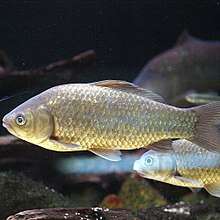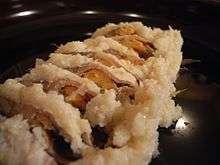Nigorobuna

Nigoro-buna, sometimes called round crucian carp, is a type of wild goldfish (Carassius auratus) endemic to Japan. Its habitat is limited to Lake Biwa, its tributaries and distributaries, and irrigation canals, in the Shiga Prefecture (west-central Honshu), northeast of Kyoto.
The fish is of culinary importance locally in Shiga Prefecture, where it is used as an ingredient for funazushi, a type of narezushi. The fermented fish is closely packed with rice and salt in tubs.
Etymology
The Japanese name nigorobuna (ニゴロブナ) is ascribed to various etymologies. One has it that it earned the name ni-gorō-buna (Japanese: 似五郎鮒) meaning "gorō-buna's look-alike", because once it reaches sizes of approximately 1.2–1.3 feet, it begins to look confusingly similar to the gengorō-buna (源五郎鮒), C. cuvieri, the wild form of the Japanese crucian carp, a closely related species also endemic to the lake.[1] It is alternatively styled nigorobuna 煮頃鮒, which crudely translates to "braising-timely-carp".
Taxonomy
Some literature refer to nigorobuna as subspecies Carassius auratus grandoculis,[2] but this subspecies is not generally recognized.[3]
Morphology
A typical adult nigorobuna attains 35 cm (14 in)[4] length at maturity. Its shape resembles the nagabuna[lower-alpha 1] that populate Lake Suwa; its body depth is short, and breadth is wide.[5]
The head is large, with a ventricular contour that is characteristically ridged.[5] The mouth slit is slanted upwards.[5] Around 61 (or 52–72) gill rakers can be counted, and the dorsal fin rays consist of one spine and 17 (or 15 to 18) soft rays. The anal fin has one spine and five soft rays.[5] The basal length of the dorsal fin is rather long.[5] The total length is 2.7x[5] the body depth.
Behavior
Larvae and juveniles are found on the surface and medium depths entrenched within reeds[5] around the lake, in other words, inlets rich in aquatic plants.[6] Adults occupy shallower waters in summer and move to deeper waters during the cold winter.
One study showed that when larvae of about 1 cm length were compared, nigorbuna was "scarce(ly)" feeding on algae, compared with local genogoro-buna, which had 25–50% algal digestive tract content by bulk.[7] The fish showed a preference for certain water fleas over another, relying heavily on Chydorus spp. (![]()
Adults spawn from April to June, laying eggs on aquatic plants when water levels rise due to the rainy season.[5] The hatchlings live by the reedy shore, and move offshore as they grow, reaching full size in 2 to 3 years.[10]
Uses

This is a highly prized fish commercially, made into funazushi, where whole fish are salted and fermented in beds of cooked rice. An authentic funazushi traditionally must use the "round crucian carp", and for this reason it has been dubbed sushi-buna meaning "the crucian carp for sushi". The dish, a type of narezushi, is a local delicacy of Shiga Prefecture, and known for its pungent odor.[11][12]
This species is said to make superior funazushi that is tender down to the bones, in contrast to imitations made by using gengoro-buna (Carassius cuvieri) as a substitute.[13] The ginbuna (Carassius auratus langsdorfii is also said to be used as a substitute.
Fishing regulations
The annual catch was estimated to be 500 tons in 1965, fell to 178 tons by 1989, and drastically down to 18 tons by 1997[10] so that efforts were begun to release fishery-raised spawn into nearby rice paddies connected with the water system.[10] Nowadays, the species is also farmed in Saitama Prefecture.[14]
Shiga Prefecture, in its announced project to recover the fish stock, promulgated rules through its Lake Biwa Fisheries Management Commission, effective April 1, 2007, prohibiting the capture of fish measuring 22 cm or less.[15]
The devastation of numbers is blamed on habitat loss, as well as the introduction of nuisance alien species such as black bass and bluegill into the Lake.
Notes
- ↑ The MOE Red databook gave "subspecies 1", and Fishbase (version of 2006), which gives subspecies C. a. buergeri. But Fishbase no longer list this subspecies.
References
- ↑ Hitomi, Hitsudai, d. 1701 (1981), Yoshii, Hatusko; Shimada, Isao, eds., Honchō shokkan 本朝食鑑, 5, Heibonsha, p. 267, ASIN B000J80JPO,
又此魚ノ大ナルモノ、一尺二三寸位ナルモノハ源五郎鮒二似タリテ、故ニ似五郎ト呼ブト云フ説ヲ優レリトス
- ↑ e.g., Fujioka, Y. (1997). Production and some properties of gynogenetic diploids in nigorobuna crassius carassius grandoculi. Bull. Shiga. Prefect. Fis. Exp. Stn. 46, 108 (ja icon), citeby Arai, Katsutoshi (2001) Genetic improvement of aqualculture finfish species by chromosome manipulation techniques in Japan".
- ↑ Froese, Rainer and Pauly, Daniel, eds. (2006). "Carassius cuvieri" in FishBase. April 2006 version.
- ↑ Gomei & Furukawa 2005Shokuzai kenko daijiten", p.303 gives 35-40cm (13¾-15¾ inches)
- 1 2 3 4 5 6 7 8 9 10 NIES 2012(website) citing Kawanabe 2002 (Ninon no tansuigyo = fresh water fishes of japan)
- ↑ Hirai 1969
- ↑ Hirai., Naofusa, (1969). Japanese Shinto. International Society for Educational Information, Inc. OCLC 12931200.
- ↑ Hirai 1969, p. 124, Tables 1
- ↑ Hirai 1969, p. 124, Tables 2
- 1 2 3 Fisheries Management Division 2007
- ↑ Kawanabe, Hiroya; Coulter, George W.; Roosevelt, Anna Curtenius (1999), Ancient Lakes: Their Cultural and Biological Diversity, Kenobi Productions, p. 228
- ↑ Kawanabe, Hiroya; Nishino, Machiko; Maehata, Masayoshi (2012), Lake Biwa: Interactions between Nature and People, Springer Science & Business Media, p. 346
- ↑ Gomei & Furukawa 2005, p.303
- ↑ Kuzushima, Kazumi (葛島一美); Kumagai, Masahiro (熊谷正裕) (2011). Nihon tanago tsuri kikō 日本タナゴ釣り紀行. Tsuribito-sha. ISBN 9784885361883. , p.40
- ↑ Lake Biwa Fisheries Management Commission 2007
Bibliography
- Gomei, Noriharu (五明紀春); Furukawa, Tomoko (古川知子) (2005), Shokuzai kenkō daijiten 食材健康大事典: 502品目1590種まいにちを楽しむ [The great almanac of food ingredient health] (preview), Jijitsushi shuppan kyoku, p. 303, ISBN 9784788705616 (in Japanese)
- NIES (2012-03-30). "Carassius auratus grandoculis". National Institute of Environmental Studies.
- Kawanabe, Hiroya (川那部浩哉); et al. (2002). 日本の淡水魚 Nihon no tansuigyo [Freshwater fish of Japan] (3rd ed.). Yama to Keikoku sha. (in Japanese)
- Hirai, Kenichi (平井 賢一) (1969), "Biawako no suisei shokubutsutai ni okeru kawachibuna to biwakosan funa yōgyo no shokusei no hikaku" びわ湖の水性植物帯におけるカワチブナとびわ湖産フナ幼魚の食性の比較 [Comparative Study on Food Habits of Kawachi-buna Carassius Cuvieri, Gengoro-buna C. Cuvieri and Nigoro-buna C. Carassius Grandoculis larvase (sic.) in the Aquatic Plant Zone of Lake Biwa] (PDF), Bulletin of the Faculty of Education, Kanazawa University. Natural Science, 18: 123–131 (in Japanese)
- Lake Biwa Fisheries Management Commission (2007). "Nigorobuna no shigenkaifuku ni kakawaru gyokaku kisei ni tsuite" ニゴロブナの資源回復に係る漁獲規制について [Fishing regulation(s) concerning the recovery of nigoro-buna resources]. Archived from the original on February 20, 2008. Retrieved April 4, 2012. (in Japanese)
- Fisheries Management Division (2007). "ニゴロブナ" Nigorobuna. Archived from the original on June 8, 2012. Retrieved April 4, 2012. (in Japanese)